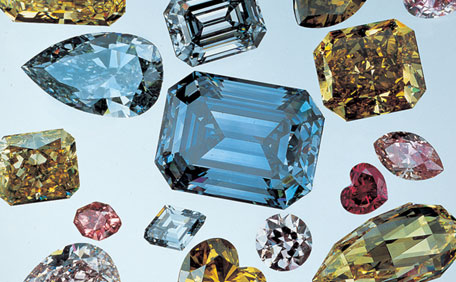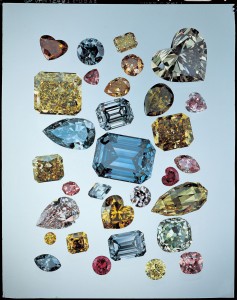When does yellow become orange, and orange become red? The question may sound a bit philosophical until you tie it to colored diamonds, where slight variations in color can mean huge differences in price.
Determining the color of a diamond is no easy task. There are a number of factors that make it especially challenging.
To start, two people can see the same color differently. Color Vision scientist Joseph Carroll went so far as to say, “I think we can say for certain that people don’t see the same colors.” One person’s velvety blue might be another person’s deep blue.
Now throw in color memory, which can be faulty. We rely on the past to decide what the color is of the object right in front of us. The red rose we admired last spring becomes the reference for the red rose this spring. But as a species, we have poor color memory: the deep red rose of last spring might have been brighter than you remembered.
Terminology is another challenge. Try describing “periwinkle” or “mauve.” In order to communicate color accurately, we need clearly defined terms and color references that can be shared.
Because the issue of color perception and communication is so complicated, an objective color standard is vital – especially when colored diamonds can sell for millions of dollars. GIA researchers had to take these factors into account when they developed a color grading system for colored diamonds.
The GIA Colored Diamond Color Grading System had its origins in the 1950s, when the Institute started receiving numerous client requests to determine if colored diamonds had been treated to improve their color. GIA continued enhancing the system by assembling masterstones (reference diamonds) in the 1960s, and creating official terminology to describe colored diamonds. It was refined once again in 1994, and this is the GIA Colored Diamond Color Grading System we know today.
GIA’s proprietary collection of masterstones may well be one of the largest of any grading laboratory in the world. GIA continually assesses the collection and these masterstones serve as permanent color references for graders.

GIA’s Pink Diamond Color Chart shows how the depth of color transitions between stones. (Note that these samples are representative only; not all diamond appearances are included. These gemstones are also not precisely positioned within the grades.)
GIA researchers also recognized that the surrounding environment, the viewer, and the light source all affected color perception. For example, the color of a red diamond can appear warmer or cooler depending on the lighting. For this reason, GIA uses the Macbeth Judge II Light Box for grading because it provides a neutral color environment and produces color-balanced lighting.
Another way GIA ensures consistency and accuracy in its grading is in its selection of colored diamond graders. Potential graders have to pass a series of tests and complete special training before they become preliminary colored diamond graders.
The result of these efforts is the GIA Colored Diamond Color Grading System – a repeatable process that removes subjectivity and ensures that a colored diamond is described accurately.
GIA’s system is recognized as the universal language for colored diamonds by virtually every gem and jewelry professional around the world, so it’s no surprise that that many of the world’s most important colored diamonds have been graded by GIA.

GIA graded this 59.6-carat diamond, named the Pink Star. Other important GIA-graded colored diamonds include: the blue Hope, the blue Heart of Eternity, the orange Pumpkin Diamond, the Moussaieff Red, the Wittelsbach Blue (renamed the Wittelsbach-Graff), and many others. Photo courtesy of Sotheby’s.
With GIA’s reliable system in place, buyers around the world can shop confidently for these rare beauties.
Custom Field: Array


